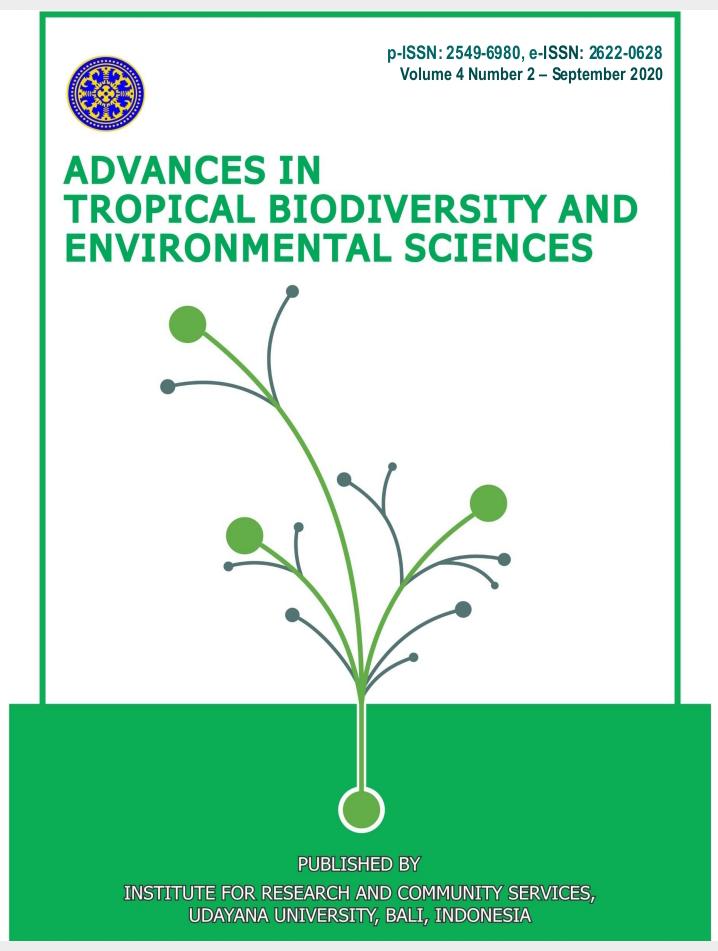Antibiotics Resistance Level of Vibrio spp. Isolated From Northern Bali Area
Abstract
One conventional method that usually done when the organism infected by pathogenic bacteria is using antibiotics, either with single or combination usage. However, the misuse of antibiotics dosages leads to resistance development of pathogenic bacteria. This study aims to determine the antibiotic resistance level of Vibrio spp. which was isolated from the waters of North Bali and to investigate the difference of resistance level between Vibrio spp. isolated from the cultivation area and outside the cultivation area. This research was conducted at the Microbiology Laboratory of BKIPM Denpasar and the Laboratory of Fisheries at the Faculty of Marine Science and Fisheries, Udayana University from November 2019 to February 2020. Antibiotic tests were carried out in vitro using 8 types of antibiotics namely tetracycline, oxytetracycline, enrofloxacin, ciprofloxacin, amoxycillin, doxycycline, ampicillin, and erythromycin with different concentrations of 0.5, 1, 2, 4, 8, 16, 32, 64, 64, 128, 256 and 512 ppm. and this test was carried out using a microplate reader to obtain absorbance values before and after incubation to determine the level of resistance of isolated Vibrios. The research showed that overall minimum inhibitory concentration (MIC) of Vibrio was below 100 ppm while the Vibrio spp. isolated from cultivation area have higher resistance level compared to outside cultivation area.
Downloads
References
[2] Fahri M. 2008. Pathogenic Bacteria in Aquaculture of Vibrio parahaemolyticus. Postgraduate Program in Aquaculture, Brawijaya University, Malang. pp 66.
[3] De Melo R, LM Almeida, DE Hofer, CM Falavina dos Reis, GND Theophilo, AFDM Santos, RHSDF Vieira. 2011. Antibiotic resistance of Vibrio parahaemolyticus isolated from pondreared Litopenaeus vannamei marketed in Natal, Brazil. Brazilian Journal of Microbiology, 42: 1463-1469.
[4] Waluyo L. 2010. Basic Microbiological Methods Techniques. UMM Press. Malang.
[5] Kusmarwati A, Y Yennie, N Indriati. 2017. Antibiotic Resistance in Vibrio Parahaemolyticus from Vaname Shrimp from the North Coast of Java for the Export Market. Center for Research on Product Processing and Biotechnology, Marine and Fisheries. Jakarta Pusat.
[6] Sutton S. 2011. Measurement of Microbial Cells by Optical Density. Journal of Validation Technologi. 17: 46-49.
[7] Astuti SD, IR Djoni, Ni’matuzahroh, M Zainuddin, Suhariningsih. 2011. Photodynamic Potential of Inactivation of Staphylococcus aureus and Vibrio cholerae with Endogenous Photosensitizer on Irradiation of Blue (430 ± 4) nm and Red (629 ± 6) nm. Berk. Penel. Hayati, 16: 127-131.
[8] Ridwan. 2004. Survey Research Methods. Pustaka LP3ES. Jakarta.
[9] Holt JG, NR Kreig, PHA Sneath, JT Staley, ST Williams. 1994. Bergey’s Manual of Determinative Bacteriology. Ninth Ed. A Wolters Kluwer Company. Philadelphia. Pp. 562-570.
[10] Faddin JFM. 1980. Biochemical Test for Identification of Medical Bacteria, London, William and Wilkins, pp. 36-40.
[11] Sarjito M, C Apriliani, AH Haditomo. 2015. Agent that causes Vibriosis in Vaname Shrimp (Litopenaeus gariepinus) Intensively Cultivated in Kendal. Jurnal Kelautan Tropis, 18 (3): 189-196.
[12] Lopatek M, K Wieczorek, J Osek. 2018. Antimicrobial Resistance, Virulence Factors and Genetic Profiles of Vibrio parahaemolyticus from Seafood. Applied and Environmental Microbiology, Vol. 84 (16).
[13] Hickman FW, JJ Farmer, DG Hollis, GR Fanning, AG Steigerwalt, RE Weaver, DJ Brenner. 1982. Identification of Vibrio hollisae sp. nov. from Patients with Diarrhea. Journal of Clinical Microbiology, 15(3): 395-401.
[14] Apriliani M, Sarjito, AH Haditomo. 2016. Diversity of agents that cause Vibriosis in Vaname Shrimp (Litopenaeus vannamei) and their sensitivity to antibiotics. Journal of Aquaculture Management and Technology, 5(1): 98-107.
[15] Caroll KC, JS Butel, SA Morse, T Mietzner, B Detrick, TG Mitchell, JH McKerrow, J A Sakanari. 2016. Jawetz, Melnick, & Adelberg’s Medical Microbiology, 27th Edition. McGraw-Hill, New York, Amerika Serikat.
[16] Sánchez S, AL Demain. 2015. Antibiotics: Current Innovations and Future Trends. Caister Academic Press, Norfolk, Inggris.
[17] Silva NMM, ISM Silva, RFS Pires, TLC Vasconcelos, MDM Viana, EA Campessato, LM Conserva, EMM Rocha., EC Araujo, MLA Bastos. 2015. In Vitro Evaluation of Antimicrobial, Antioxidant, dan Larvicidal Activities from Extract of Zeyheria tuberlusa (Vell) Bur. (Biognoniace). Journal of Chemical and Pharmaceutical Research, 7: 319-328.
[18] Sunaryanto A, A, Mariyam. 1987. Occuraence of Pathogenic Bacteria Causing Luminescene in Penaeid Larvae in Indonesia Hatcheries. Bull. Brackhis Water Aqua. Devl. Centre, 8, 64-70.













